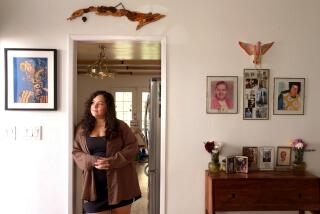A Nifty Cover-Up: Students Make Old Walls Look New
- Share via
Hello, walls. How’d things go for you today?
--from “Hello, Walls,”
a song by Willie Nelson
Edward T. Barrie has spent a lot of time asking himself--and the walls--that very question.
Barrie spends a lot of time being intimate with walls.
And why? Well, you have to be, he said. You have to be if you want to be good.
A good wall coverer--which Barrie is--has to prepare walls, soothe walls and finally cover walls with vinyl-coated papers that bring to mind everything from Matisse and Van Gogh to ugly shades of brown and blue that look either like peanut butter or a gloom-and-doom sky.
Barrie, 46, is a professional wall coverer, a teacher of wall covering, and the owner of California School of Wallcoverings, which specializes in “careers in paperhanging.”
The term wallpapering died a quiet death several years ago, Barrie said solemnly, explaining that wall coverings ceased to be papers long ago. They are now vinyl-coated covers . The terminology is one of the first things Barrie teaches.
Barrie said he sometimes feels like the father of a legion of wall coverers. He has taught hundreds of wall coverers since founding the school in 1979.
According to Barrie, the school--on Union Street downtown--is one of four such centers in the country. Most wall covering schools are run through colleges or union-sponsored trade schools. His is different, Barrie said, focusing on wall covering as a career , with no diversions into painting, decorating or artistic design.
He said the teaching is also different, describing it as “heavy, hands-on intensity.” Students spend all day long papering the same walls over and over and over.
The students--limited to 12 a class--come from all over the country. They pay Barrie $2,595 for an eight-week course. Barrie and his wife, Carolyn, teach four such courses a year.
He said that most students move on to professional careers, earning as much as $50,000 a year. He said the courses are evenly divided among men and women, a change that has occurred only in the last few years.
“Women actually hold the advantage as wall covering professionals,” he said. “In the case of wall covering, they benefit from stereotypes. Customers feel women will naturally be neater, cleaner, more meticulous. People still seem to think that men are more careless, prone to spilling tobacco juice or dropping cigarette butts.
“Some seem to think they can take advantage of women financially. We’ve found that women grads actually cut better deals and have more savvy financially.”
The average age of Barrie’s students is 32, with the range from 17 to 65. A student’s salary--once he or she graduates--is based on the cost of rolls of wall covering, combined with labor costs. Barrie said labor usually runs between $12 and $15 a roll, and the rolls average $13. He said most graduates start out making around $20,000 their first year, and salaries escalate sharply after that. As with any work, he said, you have to work hard to make it go.
Barrie feels paternalistic in trying to guide students through adventures in wall covering.
“You encounter all sorts of crazy things,” he said. “Crooked walls and archways, strange configurations in windows. It really gets exciting in San Francisco and places Back East, with all those old houses. It’s a lot more conservative around here.”
In teaching a mastery of the extraordinary, Barrie deliberately screws up the walls and corners of his students’ work spaces. Like any good father, he teaches his charges to somehow master the disasters.
Learning From Mistakes
“When I first started, I had this tendency to protect students from all harm,” said Barrie, who has two children, ages 13 and 9. “I soon learned you have to let them screw up. Everyone learns from mistakes. It’s the old way but the only way.”
Susan Counley, 33, from Denver, a student in the current course, “blew a wall covering job” back home, then heard from a guy in the business that Barrie “could straighten me right out.” She said she had learned how to handle seams better, prepare walls more elaborately and carefully, and to determine which sealants go with which covers.
It’s all part of getting “intimate” with walls, she said.
Barrie finds that most students--and Counley is a good example--are “remarkably homogeneous.” They desire the calling out of a heartfelt need to structure their own schedules or to simply work for themselves free of bosses and constraints.
Most are free-lancers who like independence.
Shelley Hoggatt, 36, who lives in Escondido, fits such descriptions. Hoggatt has two children, ages 8 and 10. She wanted a job that wasn’t 40 hours a week in an office.
More to Read
Sign up for Essential California
The most important California stories and recommendations in your inbox every morning.
You may occasionally receive promotional content from the Los Angeles Times.










